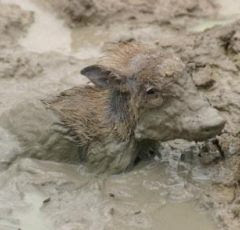California’s oil and gas fields produce billions of gallons of contaminated waste-water each year, and much of this contaminated fluid is injected underground. California has an estimated 2,583 waste water injections wells, of which 1,552 are currently active in different ares throughout the state. For sure i'm gonna get emails say, "lay off Califiornia, eh, it's no worse than most places". Ain't that the truth, but California grows so much of the US and Canadian food supply, it's in a mega-drought, its pumping its aquifers dry, the snows ain't there to re-fill the dam damns, the urban sprawl gallops everywhere in the desert southwest laying more of water pipe for more houses...etc.
Ironically, Tulare County, in the San Joaquin Valley of California and home of Tulare Lake, ran out of tap water a couple of weeks ago and is now trucking in everything due to that state’s never-ending mega-drought. Another report says chances are increasingly high that California and other states could be facing a water crisis worse than anything seen in 2,000 years. "Nobody knows how disastrous it's going to be" say most California water experts in their private moments over a beer.
Much of Tulare Lake is now disguised as interstate highway but this too shall pass someday.
On average, groundwater resources are 5000-years old. That is, it takes, on average, 5000 years for a drop of rain that makes its way into a freshwater aquifer to make its journey to a spring or the sea. By contrast, river waters globally average a residence time of 17 days between rain and entry to a sea (if they aren't sucked out first). On average a water molecule spends around 8 days in the atmosphere once evaporated from a surface water body or transpired from vegetation before returning as precipitation.
This 5000-year (fresh) groundwater residence time is important because 1) it demonstrates that groundwater mining (extracting at a net rate that exceeds replenishment) is a serious problem and 2) that pollution of such resources will take heroic measures to mitigate, if even possible. Groundwater is special. Mistakes regarding it are more or less permanent.
But, as we all know, corporations have only one master - shareholder profits. It's far more effective to use a few bucks to buy off the politicians than conform to the regulations they might impose on the flow of shareholder cash. So it sure appears meaningful government regulations are impossible without a 9.0 earthquake event.
That very earthquake is coming, one way or another, with or without regulations. The best option IMO is already well unfolded - demand reduction fueled degrowth and modest deflation. The DOW has dropped 1500 points in 3 weeks, Asia's oil demand is off 60% in the last year, the petrodollar is dodging BRICS but wobbly. In reponse - panic is currently gripping global central-planning headquarters as pictured below courtesy of Victor Leonardi:




